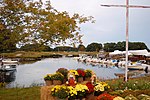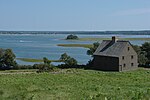Essex Shipbuilding Museum

The Essex Shipbuilding Museum is a maritime museum in Essex, Massachusetts which contains historical and demonstrative displays regarding the history of the wooden shipbuilding industry in Essex. Essex produced more wooden fishing schooners between 1668 and the twentieth century than anywhere else in America. The museum contains various ship models and half hulls including several on display from the Smithsonian Institution. Displays include antique shipbuilding tools, photos, and dioramas of the former shipyard. The museum also features the Evelina M. Goulart, an Essex-built schooner built in 1927. Adjacent to the museum is a boat yard owned by the Story Family, which still constructs and launches wooden ships built in the Essex tradition.
Excerpt from the Wikipedia article Essex Shipbuilding Museum (License: CC BY-SA 3.0, Authors, Images).Essex Shipbuilding Museum
Main Street,
Geographical coordinates (GPS) Address Website Nearby Places Show on map
Geographical coordinates (GPS)
| Latitude | Longitude |
|---|---|
| N 42.6327 ° | E -70.7794 ° |
Address
Essex Historical Society and Shipbuilding Museum
Main Street
01929
Massachusetts, United States
Open on Google Maps










